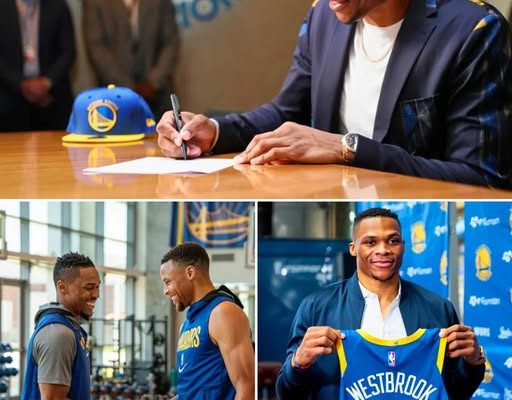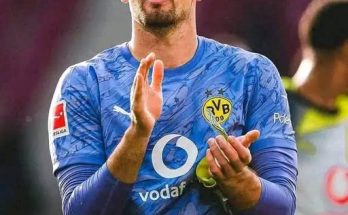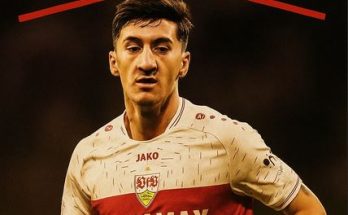In a move that has already sent shockwaves through the NBA, the Golden State Warriors have pulled off one of the most surreal and surrealistic signings in recent memory, bringing in a former league MVP on a one-year veteran minimum deal. Not just any MVP — but one who was, at one point, Stephen Curry’s most bitter on-court rival and arguably the face of an opposing basketball philosophy. A deal like this wasn’t just unpredictable — it was thought to be unthinkable. Yet here we are. The news is real. The signature is inked. The Warriors, known for their meticulous planning and loyalty to their championship core, have decided to bet their chips on someone who once stood across from them as a legitimate threat to their very identity. The NBA world is already reeling from the implications, with opinions ranging from excitement to confusion to outright skepticism. It’s not just that this player is past his prime or a gamble physically. It’s that this marriage of basketball ideologies seems so strange, so combustible, that you almost wonder if Golden State is testing fate for one last dance.
The Warriors have spent the past few seasons trying to juggle competing timelines — clinging to the Steph-Draymond-Klay nucleus while attempting to develop young talent like Jonathan Kuminga and Moses Moody. They gave up on the James Wiseman experiment. They traded Jordan Poole. They doubled down on veterans like Chris Paul last season and saw the results come back mixed. The margin for error, as it stands, is paper-thin. And yet instead of recalibrating toward youth or exploring a modest rebuild around Curry’s twilight, they have opted for a gamble so bold that it defies conventional NBA logic. What the front office has done, quietly and without media fanfare, is signal that they’re not going out quietly. They are trying, however controversially, to load up for one last push toward title contention — even if it means taking on a volatile personality whose past might indicate more chaos than cohesion.
Sources close to the organization say the conversations began at the start of free agency but didn’t pick up serious steam until Curry himself got involved. Curry, ever the unifier, reportedly made the call that changed everything. His willingness to look past old rivalries, past conflicts, and past media narratives seems to have been the catalyst in making this deal even feasible. Those inside the locker room know how much influence Curry holds. He’s not just the franchise’s best player — he’s the emotional center of gravity. If he buys in, others fall in line. Still, that doesn’t erase the tension that’s bound to come with this new addition. The former MVP is known not just for his play, but for a personality that has rubbed teammates, coaches, and even fanbases the wrong way. This isn’t just a basketball move. It’s a psychological experiment — one that will test the limits of camaraderie, leadership, and sacrifice.
The Golden State brand of basketball — motion-heavy offense, selflessness, joy — has always contrasted sharply with the lone-wolf, isolationist ethos that this new signing once embodied. The irony is thick. Here is a player who once challenged the Warriors in the playoffs, who once engaged in fiery staredowns with Curry, who built a brand off being the anti-Warrior — now suiting up in the very same jersey he once targeted. The arc here is dramatic, almost cinematic. And that’s precisely why fans can’t stop talking about it. This isn’t just about what happens on the floor. This is about legacy. Redemption. Control. Can both sides set aside ego in the name of championship glory?
From a basketball standpoint, the fit raises obvious questions. While this MVP still has undeniable skills — an ability to create his own shot, make plays in isolation, and rise in big moments — his strengths often require a level of ball dominance that the Warriors’ system doesn’t typically accommodate. Golden State thrives on ball movement, player movement, and trust. Their offense hums when everyone is involved. The question becomes: can this former alpha dog accept a secondary or even tertiary role? Can he play off the ball, make the extra pass, defend within a complex switch-heavy scheme? These aren’t minor adjustments — they’re fundamental identity shifts. And yet the Warriors must believe he’s capable of making them. Otherwise, they wouldn’t have extended this offer, no matter how inexpensive it looks on paper.
Of course, the veteran minimum nature of the deal means this is a relatively low-risk proposition financially. The real cost is chemistry. The real gamble is emotional. The Warriors are betting that their culture — anchored by Steve Kerr’s leadership, Curry’s humility, and Draymond Green’s volatile-but-effective edge — is strong enough to absorb a wildcard like this. They’ve done it before, to be fair. When they brought in Kevin Durant, there were concerns about ego and fit, and those concerns were largely overcome by the sheer overwhelming talent on the roster. But this situation is different. Durant was in his prime. This former MVP is not. Durant had no significant history of clashing with Curry. This player does. The dynamics are more fragile now. One wrong turn, one passive-aggressive quote to the media, one stretch of poor shot selection, and the house of cards could fall quickly.
Some insiders suggest this move was born not just out of hope, but out of necessity. The Warriors didn’t have the cap space or trade assets to land another star via traditional means. They were boxed in. Their options were limited. With Klay Thompson now in Dallas and Draymond another year older, Golden State may have simply decided that a veteran with a high ceiling, even if erratic, was better than running it back with the same core and expecting different results. The player himself, sources say, was looking for redemption. He’s bounced around in recent years, falling out of favor with coaches and GMs alike. He’s been labeled difficult, polarizing, even washed. But he still believes in his ability to compete at the highest level. Joining the Warriors is his chance to prove it. He doesn’t need to be the number one option anymore — he just wants to matter.
Privately, some Warriors players have expressed cautious optimism. The idea of adding a seasoned scorer who has seen every defense imaginable does have upside. In a playoff series, when possessions slow down and half-court execution becomes paramount, having someone who can get you a bucket in isolation isn’t a bad thing. It’s not how the Warriors typically operate, but having that card in your back pocket is valuable. The key will be meshing that style with their existing rhythm. Can the coaching staff stagger minutes effectively? Can they build an ecosystem where this former MVP feels empowered, but not entitled? These are tough questions with no obvious answers. But if there’s a team equipped to try, it’s Golden State.
The larger narrative, of course, extends beyond the court. This move forces fans and media alike to reassess long-held beliefs about rivalries, grudges, and the fluidity of identity in modern sports. In today’s NBA, loyalty is often secondary to fit, opportunity, and timing. Players once viewed as enemies can become allies overnight. Front offices are more pragmatic than ever. Emotional history matters less than upside. But even in that context, this deal feels monumental. It’s a rupture in the natural order. A once-warring figure now dons the jersey of his rival, possibly for his final chapter. What happens next will be closely watched — not just for its impact on the standings, but for what it says about the nature of competition, forgiveness, and reinvention.
There’s also the matter of media scrutiny. This is not a player who flies under the radar. He attracts headlines, for better and for worse. Every interaction, every quote, every missed shot or fiery exchange will be analyzed to death. The Warriors, already one of the most scrutinized teams in basketball, now have a circus-sized spotlight overhead. If things go well, the story will be about bold vision and dramatic redemption. But if things unravel, the blame will be swift and unforgiving. The risk of implosion is real. Chemistry is fragile. And the NBA season is long. Frustrations build. Rotations fluctuate. Minutes vanish. The challenge ahead isn’t just tactical. It’s human.
One source close to the situation summed it up simply: “They know this might not work. But they also know if it does, it could be magic.” That sentiment seems to capture the mood in the Bay Area. Cautious hope. Defiant belief. A willingness to try something radical, not because it guarantees success, but because standing still felt like the greater failure. For a franchise built on breaking the mold — from small-ball revolutions to redefining the three-point shot — maybe this move is just the next chapter in that ethos. Maybe it’s less about logic and more about faith. Faith in culture. Faith in people. Faith in the idea that sometimes, your enemy today can be your partner tomorrow.
In the end, the court will decide. There will be no hiding from it. Whether this partnership thrives or combusts, the games will expose the truth. The fans will see it. The media will spin it. The front office will live with it. But for now, in the stillness before training camp, it remains one of the most fascinating experiments in recent NBA memory. A former MVP. A once-hated rival. A dynasty clinging to one final gasp of glory. One year. One deal. One chance to turn what could be a disaster into something unforgettable. The Warriors didn’t just sign a player. They ignited a storyline. And now, the whole league is watching.



